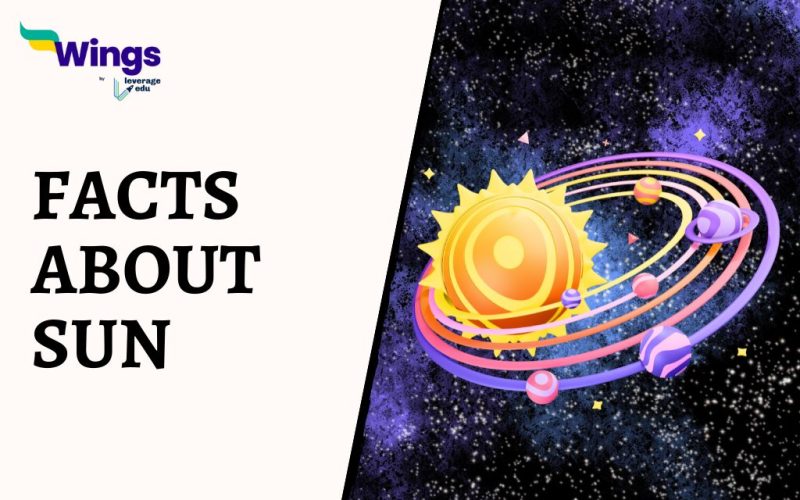Facts about Sun: The Sun is a star at the centre of our solar system, providing the Earth with light and heat that sustain life. It is a massive ball of hot plasma, with a diameter of 1.39 million kilometres and a mass 330,000 times that of Earth. The sun was formed approximately 4.6 billion years ago from the gravitational collapse of a giant molecular cloud. It is mainly composed of hydrogen (73%), helium (25%), and small amounts of heavier elements. Despite its immense size, the sun appears small from Earth due to its distance of 150 million kilometres. Read this blog hereon, to learn some more figures and facts about the sun, a blazing star of our solar system.
Table of Contents
Unknown Facts About Sun as a Star
The Sun, a colossal ball of hot plasma, is the heart of our solar system, influencing life on Earth through its light and energy. Here are some unknown facts about the sun that you need to know:
- The core of the sun is about 15 million degrees Celcius.
- The sun’s surface temperature is around 5,500 degrees Celsius.
- The sun is a sphere of hot plasma, heated to a certain level by nuclear fusion reactions at its core.
- The sun’s diameter is about 109 times that of the Earth.
- The sun makes up 99.8% of the mass of the entire solar system.
Also read: 10 Interesting Facts About Day and Night
Scientific Facts About Sun
The Sun, a vital star at the centre of our solar system, is not only essential for life on Earth but also has numerous unrealistic characteristics. Here are some fun facts about the sun:
- The sun is located about 24,000 to 28,000 light-years from the centre of the Milky Way galaxy.
- The sun orbits the Milky Way galaxy’s centre at a distance of about 25,000 to 28,000 light-years from it.
- The sun completes one orbit around the Milky Way galaxy’s centre every 225-250 million years.
- The sun, which is also known as ‘yellow dwarf’, is a G-type main sequence star.
- The absolute magnitude of the sun is +4.83.
- The sun’s luminosity is 3.828×1026 watts.
- The sun’s surface area is 6.09×1012 square kilometres, about 12,000 times that of Earth.
- The sun’s volume is 1.41×1018 cubic kilometres, about 1.3 million times that of Earth.
- The average density of the sun is 1.408 grams per cubic centimetre.
- The sun’s equatorial surface gravity is 274 m/s2, about 28 times that of Earth.
- The sun’s escape velocity is 617.6 km/s, about 55 times that of Earth.
Also read: Fun Facts About The Largest Planet Saturn
Did You Know These Facts About Sun?
The Sun, a magnificent star at the centre of our solar system, is essential for life on Earth. Its immense energy and unique characteristics make it a subject of endless fascination. Here are some amazing facts about the sun:
- The sun’s rotation period is 25.05 days at its equator and 33.5 days at its poles.
- The sun’s magnetic field strength at its surface is 1-2000 gauss.
- The sun’s magnetic field extends out into space, forming the heliosphere, a bubble in the interstellar medium.
- The sun’s magnetic field reverses its polarity approximately every 11 years.
- The sun’s corona, or outer atmosphere, has a 1-2 million degrees Celsius temperature.
- The sun’s energy comes from nuclear fusion reactions in its core, where hydrogen is converted into helium.
- The sun’s light takes 8 minutes and 20 seconds to reach Earth.
- The sun’s light provides Earth with the energy needed to power the water cycle and wind.
- The sun’s ultraviolet radiation is essential for vitamin D production in humans and other animals.
- The sun’s energy is used for solar power, a renewable energy source
FAQs
The Sun’s core reaches temperatures of about 15 million degrees Celsius, where nuclear fusion reactions convert hydrogen into helium, generating the Sun’s vast energy.
Sunlight takes approximately 8 minutes and 20 seconds to travel from the Sun to Earth, covering the 150 million kilometres between them.
The Sun’s magnetic field reverses its polarity roughly every 11 years, a phenomenon tied to the solar cycle and sunspot activity.
Related Blogs
Hope you had fun reading these interesting facts about Sun. If you like reading about facts, you can visit our interesting facts page to read more such blogs.
 One app for all your study abroad needs
One app for all your study abroad needs













